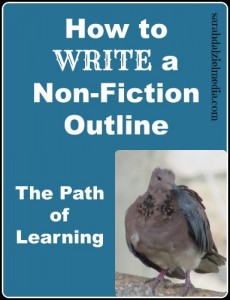Outlines are essential for any work longer than one thousand words, whether fiction or non-fiction. Even shorter non-fiction works may need outlines if they are cover letters, or for any other specific purpose. Many of the steps in writing non-fiction are the same as those for fiction. 
You should always use your favorite writing tools for outlining. Though with non-fiction a pen and paper may end up taking longer than is necessary. I prefer Word for short non-fiction, but would recommend a dedicated writing program for book length non-fiction.
Differences Between Writing Fiction and Non-Fiction Outlines:
With fiction you are trying to go from plot point A to plot point Z with as much action and tension as possible, without going overboard. With non-fiction you are presenting information, and leading a person’s thoughts through different options, techniques, or information.
With Non-fiction you need to focus on the development of the thought, as opposed to plot, and try to go in the most logical method possible. Each section should build on the preceding section, and have some type of support. Support can be personal experience or experimentation, or citing from a recognized source of research.
For things like an academic paper, often the best outline is the rubric itself, combined with relevant quotes from the reading. Making a quote outline and then just writing the paper around the quotes is actually one of the most efficient ways to create a good academic paper. You can’t really do that with a book, but you can form your book around anecdotes, evidence, and challenges.
Writing the Non-Fiction Outline:
The first question is “what will I learn” while reading this, or while writing if you like researching new topics for your writing. Once you’ve established what you will learn, the next question is “how much depth should I research” which will determine the length, and breadth of your book.
Once you have those two questions answered, form chapter headings and sub-headings on what you will learn, and what you will research. Those will give you the outline for your book.
Once you have your outline, flesh it out with a few descriptive paragraphs or notes of what you still need to research. Add a few spots for personal stories, sayings, or relevant quotes, and then start writing. Or, go back to researching if it’s a new topic and write as you research.
Back To You:
I hope you’ve checked out my other articles on outlining and that this article was informative and helpful. If you have any input, leave a comment. I love to hear from my readers.

Leave a Reply